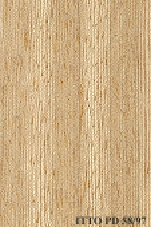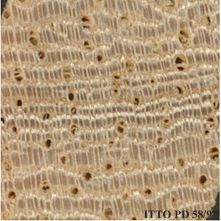
CAXINGUBA (Ficus schultesii)
Trade Name
Caxinguba
Scientific Name
Ficus schultesii Dugand
Family
MORACEAE
Common Names
Ojé Renaco (Peru); Caxinguba (Brazil); Renaco (Peru); Ojé (Peru); Figuier; Higuerón; Figueira (Brazil)
Description Of The Tree
Botanical Description
The tree size is up to 40 m, with a trunk diameter that can reach up to 150 cm in diameter or more. It usually develops a cylindrical bole, with well developed buttresses which are 4 to 6 m tall. Ficus trees have abundant latex.
Natural Habitat
Ficus schultesii prefers non-inundable lowlands or moderate slopes, up to 700 m of altitude.
Natural Distribution
This species is reported in the tropical forests of Brazil, Colombia and Peru. In Peru it is common in the forests of the departments of Huanuco, Loreto, San Martin and Madre de Dios.
Non Timber Uses
This species is very sensible to biological attack. The latex of Ficus trees is reported to have a vermifuge effect.
Wood Identification
Anatomic Description Of Wood
Occasionally vessels exclusively solitary (over 90%). Tangential diameter of vessel lumina 200 micras or more (large). Vessels per mm2 less than 6 (rare). Axial parenchyma in thick bands. Larger rays more than 4 seriate.
-
 Wood Macro Photo Radial Plane
Wood Macro Photo Radial Plane
-
 Wood Micro Photo Of Transversal Section
Wood Micro Photo Of Transversal Section
Availability
Cites Status
Unrestricted
General Wood Description
Odor
The wood has no specific odor or taste.
Color
The sapwood is differentiated, it is white, the heartwood is pale brown when dry.
COLOR INDEX (1=Black, 7=Light yellow,white)
6
Grain
The grain is usually interlocked.
Texture
This wood has a somewhat medium texture.
Luster
The wood surfaces tend to be moderately to highly lustrous
Natural Durability
This species has little natural durability against fungi and insects.
Natural durability index (1= Very high durability, 7=Vey low durability)
5
Resistance To Impregnation
It is easy to preserve.
Wood Physical Properties
Basic Density or Specific Gravity (O.D. weight/vol. green) (g/cm³)
0.36
Air-dry Density (Weight and volume at 12%MC) (g/cm³)
0.38
Total shrinkage Tangential (Saturated to 0%MC) (%)
7.8
Total shrinkage Radial (Saturated to 0%MC) (%)
2.8
Drying Defects
Ease of Drying: It is reported to dry rapidly. Drying Defects: Slight checking and moderate warping are reported.
Dimensional stability ratio (Total Tangential Shrinkage %/Total Radial Shrinkage %)
2.8
Wood Chemical Properties
Wood Mechanical Properties
Bending Strength (MOR),12%MC (kgf/cm²)
579
Stiffness (MOE) 12%MC (kgf/cm²)
64437
Compression parallel to fiber 12%MC (kgf/cm²)
327
Shear strength radial 12%MC (kgf/cm²)
46
Janka hardness (side) 12%MC (kgf)
143
Janka hardness (end grain) 12%MC (kgf)
256
Workability
Sawing
Sawmilling of this species is reportedly easy.
Rotary Veneer Cutting
In Peru this species is used for plywood and decorative veneer.
Sliced Veneer
In Peru this species is used for plywood and decorative veneer.
Blunting Effect
Wood of this species exerts a slight blunting effect on the cutting tools.
Machining
Machining of this species is reported to be easy.
Planing
Planing is reported to be easy.
Nailing
Nail-holding properties are poor.
REFERENCED USES
End Uses Summary
HOUSING GENERAL, FURNITURE AND CABINETS, PLYWOOD AND VENEER, Decorative veneer, OTHER AND MUSICAL INSTRUMENTS, moldings
General Housing
- 10 - Silica in Timbers
Furniture Cabinets
- 21 - Tropical timbers of the world. Part III-Southeast Asian and Oceanian Species.
Panels, Veneers
- 25 - Directory of Timber Trade Malaysia
Decorative veneer
- 28 - Ministry of Agriculture, Fisheries & Forest of Fiji
Molding
- 79 - Padronização da Nomenclatura Comercial Brasileira das Madeiras Tropicais Amazônicas, Sugestão
Please Provide Information To View Producer Information